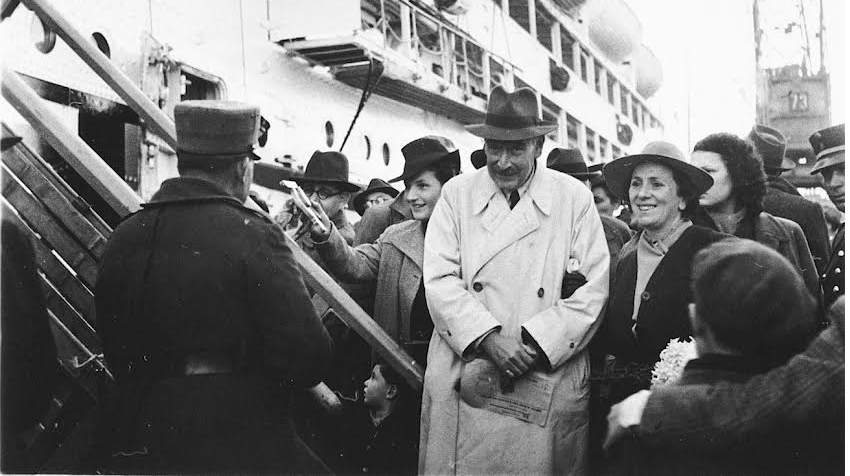Chabad Portugal Association in partnership with the port of Lisbon and Lisbon city council paid tribute to the ship Serpa Pinto that transported thousands of passengers across the Atlantic Ocean during the Second World War, saving both lives. The ceremony was held on November 21st in the port of Lisbon - Rocha Conde de Óbidos.
Portuguese liner Serpa Pinto weighed anchor in Lisbon on June 12, 1941 (Sivan 17, 5701) and set sail across the Atlantic Ocean, eleven days later, on June 23, the 28th day of Sivan. Rabbi Menachem Mendel Schneerson, son-in-law and future successor of the Lubavitcher Rebbe, and his wife, Chaya Mushka, disembarked from the ship in Staten Island, New York, together with hundreds of other refugees from Nazi-occupied Europe.
For the Chabad community all over the world, Sivan 28 became a special occasion for rejoicing. Known as yom ha-bahir, “the inspirational day,” it signifies a turning point in the revival of Judaism in the United States and the entire world.
Unfortunately, we have few details about the future Rebbe’s brief stay in Portugal, with the exception of some notes for what may have been a lecture delivered in Lisbon’s Shaare Tikvah synagogue and on a very text, taken from the Sanhedrim treatise of the Talmud, on the coming of Moshiach: "The son of David will only come when they look for a fish for the sick and none will be found."
A Safe Haven
Tens of thousands of Jewish and non-Jewish refugees found temporary refuge in Portugal during World War II. This was thanks in great part to Aristides de Sousa Mendes, the Portuguese consul in Bordeaux, France. Mendes issued thousands of Portuguese visas despite official orders not to allow “foreigners of indefinite or contested nationality, the stateless, or Jews expelled from their countries of origin” to enter the country.
Approximately 40,000 people crossed the Franco-Spanish border between 1940 and 1941, many of them bound for Portugal.
Neutral Portugal seemed like an oasis, far away from bloody battlefields, curfews and air-raid sirens. “In 1940 Lisbon, happiness was staged so that G‑d could believe it still existed”, wrote the famous French writer (and future fighter pilot) Antoine de Saint-Exupery.
At night, cafés in the brightly lit streets greeted crowds of cosmopolitan customers, though the atmosphere of freedom was somewhat tempered by the staggering number of spies. Pro-Allied and pro-Axis supporters were active in Lisbon, frequently sparring in public and private. Both distributed propaganda and tried to convert the local population to their ideologies.
Though the average man on the street supported the Allied forces, got his news from the British Broadcast Corporation (BBC) and wore the Royal Air Force insignia on his lapel, Portuguese state officials, police and military commanders counted many Nazi sympathizers among their ranks.
Under Antonio de Oliveira Salazar, the pro-Nazi elements in the government eventually stemmed the tide of refugees, and anti-Nazi militants, both Jewish and non-Jewish, were arrested and imprisoned by the secret police. From 1942 onward, most refugees arriving in Portugal from France did so illegally.
Fortunately, the future Rebbe and Rebbetzin passed through Lisbon before restrictions grew too great.
Desperate to Escape
Leaving Europe during World War II required tremendous effort, and resources that most would-be emigrants did not possess.
Some well-to-do refugees were able to afford expensive seats aboard Clippers, the “flying ships” of Pan American Airways, which linked America to Europe twice a week. But the majority of refugees in Lisbon had only one option: to obtain the necessary visas and secure passage on board one of the Portuguese liners continuously crossing the Atlantic. Havana, Philadelphia, Baltimore, New York and Rio de Janeiro were among the most desired destinations.
In the Portuguese capital, exhausted refugees scrambled to gather the long list of materials necessary to emigrate. They visited understaffed consulates, crowded travel agencies, and waited for long hours in queues to obtain financial and administrative assistance from relief organizations.
Despite their network of connections, the future Rebbe and Rebbetzin were not exempt from the trials of this process. Before they arrived in Lisbon, they spent a tense period in Nice awaiting special visas that would allow them to leave Europe and come to America.
Finally, on the 20th of Nissan, after intense lobbying on their behalf, they received visas from the United States consul in Marseille. Chassidim in New York with connections in the Portuguese government secured them transit visas, and they passed legally into Portugal.
Crossing the Ocean
Because travel was expensive and dangerous, few ships undertook transatlantic journeys. The Joint Distribution Committee (JDC), headquartered in Lisbon, purchased in advance all or most of the passenger space on some of the ships owned by the Colonial Shipping Company (CCN), and distributed it to refugees. The JDC posted between $180,000 and $260,000 as a guarantee for each journey, a huge sum at the time.
Founded in 1922 in Angola, a Portuguese colony in Africa, the CCN owned a dozen liners that could each carry several hundred passengers. Some CCN liners were well known by Jewish refugees, such as the Nyassa, or the Guinea, which sailed to Palestine.
But the most famous CCN ship of all was the liner that carried the future Rebbe and Rebbetzin to safety in June 1941: the Serpa Pinto. During the war years, the Serpa Pinto achieved a kind of celebrity as it transported over 110,000 passengers across the Atlantic Ocean, more than any other Portuguese civilian ship.
The ship made her debut during World War I, when she escorted Allied convoys as the armed British RMS Ebro. After the war, a Yugoslavian company acquired the ship and, as the renamed Princeza Olga, she sailed over a period of five years between the ports of Dubrovnik and Haifa.
In 1940, a few weeks before the Nazis invaded the Balkans, the ship was resold to the CCN and renamed the Serpa Pinto (after a famous 19th-century Portuguese explorer of eastern Africa). She immediately began traversing the Atlantic, reaching ports in North and South America.
Even for neutral ships, crossing the Atlantic Ocean was an extremely dangerous affair. Nazi submarines mercilessly hunted Allied vessels, sinking them whenever possible.´
Precious Cargo
Once the future Rebbe and Rebbetzin arrived in Lisbon, passage on a transatlantic vessel was all but secured. At the last moment they received tickets on the sold-out Serpa Pinto, scheduled to set sail on June 12, 1941, and though the threat of torpedoes loomed, the ship reached neutral waters safely and landed in New York City eleven days after leaving Europe.
Today, long after her 1955 dismantling in a Belgian scrapyard, the Serpa Pinto remains dear in the memories of thousands of Jewish and non-Jewish refugees. Known as the navio da amizade, the “friendship ship,” she transported precious cargo across dangerous seas as doors rapidly closed for Jewish refugees from Europe.

































